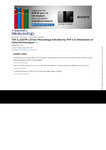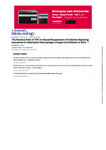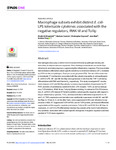TGF-beta and IFN-gamma direct macrophage activation by TNF-alpha to osteoclastic or cytocidal phenotype.
Date
2000Author
Subject
Metadata
Show full item recordAbstract
<jats:title>Abstract</jats:title> <jats:p>TNF-related activation-induced cytokine (TRANCE; also called receptor activator of NF-κB ligand (RANKL), osteoclast differentiation factor (ODF), osteoprotegerin ligand (OPGL), and TNFSF11) induces the differentiation of progenitors of the mononuclear phagocyte lineage into osteoclasts in the presence of M-CSF. Surprisingly, in view of its potent ability to induce inflammation and activate macrophage cytocidal function, TNF-α has also been found to induce osteoclast-like cells in vitro under similar conditions. This raises questions concerning both the nature of osteoclasts and the mechanism of lineage choice in mononuclear phagocytes. We found that, as with TRANCE, the macrophage deactivator TGF-β1 strongly promoted TNF-α-induced osteoclast-like cell formation from immature bone marrow macrophages. This was abolished by IFN-γ. However, TRANCE did not share the ability of TNF-α to activate NO production or heighten respiratory burst potential by macrophages, or induce inflammation on s.c. injection into mice. This suggests that TGF-β1 promotes osteoclast formation not only by inhibiting cytocidal behavior, but also by actively directing TNF-α activation of precursors toward osteoclasts. The osteoclast appears to be an equivalent, alternative destiny for precursors to that of cytocidal macrophage, and may represent an activated variant of scavenger macrophage.</jats:p>
Collections
Publisher
Place of Publication
Journal
Volume
Issue
Pagination
Recommended, similar items
The following license files are associated with this item:
Related items
Showing items related by title, author, creator and subject.
-
The Possible Role of TGF-β-Induced Suppressors of Cytokine Signaling Expression in Osteoclast/Macrophage Lineage Commitment In Vitro.
Fox, Simon; Haque, LJ; Lovibond, AJ; Chambers, TJ (The American Association of ImmunologistsUnited States, 2003-04-01)<jats:title>Abstract</jats:title> <jats:p>Osteoclast formation is dependent on the ability of TGF-β to enable receptor activator of NF-κB ligand (RANKL)-induced commitment of hemopoietic precursors to the ... -
Macrophage subsets exhibit distinct E. coli-LPS tolerisable cytokines associated with the negative regulators, IRAK-M and Tollip
Al-Shaghdali, K; Durante, B; Hayward, C; Beal, J; Foey, Andrew (Public Library of ScienceUnited States, 2019-05-23)Macrophages (Mϕs) play a central role in mucosal immunity by pathogen sensing and instruction of adaptive immune responses. Prior challenge to endotoxin can render Mφs refractory to secondary exposure, suppressing the ... -
Macrophage-Derived Slit3 Controls Cell Migration and Axon Pathfinding in the Peripheral Nerve Bridge
Zhang, He; Carr, L; Woodley, P; Barry, R; Drake, L; Mindos, T; Robert, S; Lloyd, A; Parkinson, David (Elsevier (Cell Press)United States, 2019-02-05)Slit-Robo signaling has been characterized as a repulsive signal for precise axon pathfinding and cell migration during embryonic development. Here, we describe a role for Sox2 in the regulation of Robo1 in Schwann cells ...





